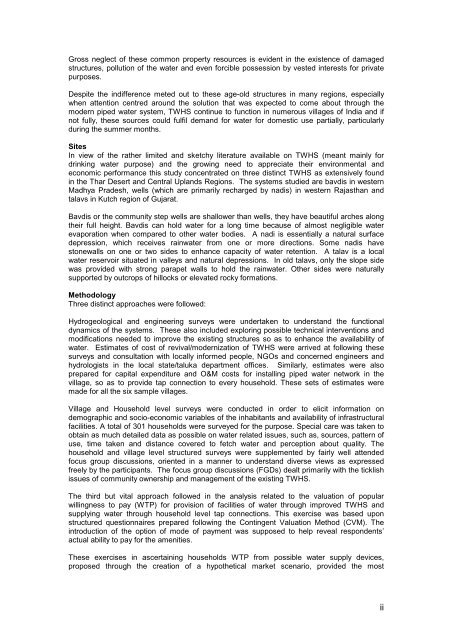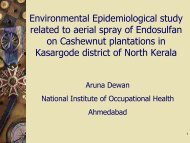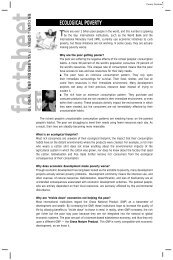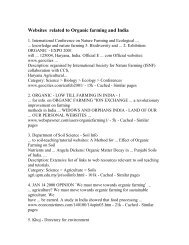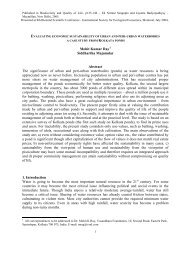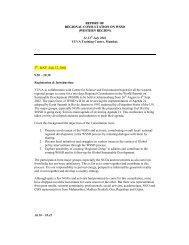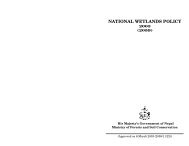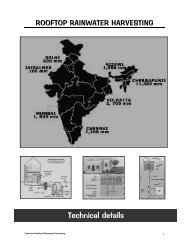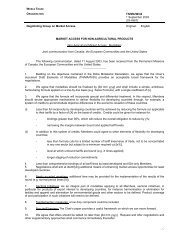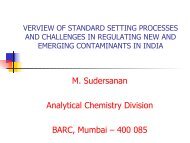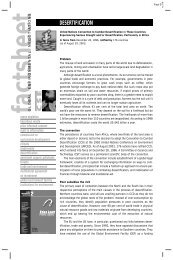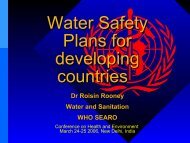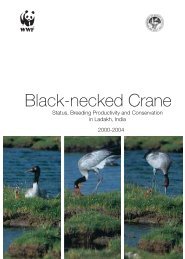Reviving a Water Heritage: - Rainwater Harvesting
Reviving a Water Heritage: - Rainwater Harvesting
Reviving a Water Heritage: - Rainwater Harvesting
Create successful ePaper yourself
Turn your PDF publications into a flip-book with our unique Google optimized e-Paper software.
Gross neglect of these common property resources is evident in the existence of damaged<br />
structures, pollution of the water and even forcible possession by vested interests for private<br />
purposes.<br />
Despite the indifference meted out to these age-old structures in many regions, especially<br />
when attention centred around the solution that was expected to come about through the<br />
modern piped water system, TWHS continue to function in numerous villages of India and if<br />
not fully, these sources could fulfil demand for water for domestic use partially, particularly<br />
during the summer months.<br />
Sites<br />
In view of the rather limited and sketchy literature available on TWHS (meant mainly for<br />
drinking water purpose) and the growing need to appreciate their environmental and<br />
economic performance this study concentrated on three distinct TWHS as extensively found<br />
in the Thar Desert and Central Uplands Regions. The systems studied are bavdis in western<br />
Madhya Pradesh, wells (which are primarily recharged by nadis) in western Rajasthan and<br />
talavs in Kutch region of Gujarat.<br />
Bavdis or the community step wells are shallower than wells, they have beautiful arches along<br />
their full height. Bavdis can hold water for a long time because of almost negligible water<br />
evaporation when compared to other water bodies. A nadi is essentially a natural surface<br />
depression, which receives rainwater from one or more directions. Some nadis have<br />
stonewalls on one or two sides to enhance capacity of water retention. A talav is a local<br />
water reservoir situated in valleys and natural depressions. In old talavs, only the slope side<br />
was provided with strong parapet walls to hold the rainwater. Other sides were naturally<br />
supported by outcrops of hillocks or elevated rocky formations.<br />
Methodology<br />
Three distinct approaches were followed:<br />
Hydrogeological and engineering surveys were undertaken to understand the functional<br />
dynamics of the systems. These also included exploring possible technical interventions and<br />
modifications needed to improve the existing structures so as to enhance the availability of<br />
water. Estimates of cost of revival/modernization of TWHS were arrived at following these<br />
surveys and consultation with locally informed people, NGOs and concerned engineers and<br />
hydrologists in the local state/taluka department offices. Similarly, estimates were also<br />
prepared for capital expenditure and O&M costs for installing piped water network in the<br />
village, so as to provide tap connection to every household. These sets of estimates were<br />
made for all the six sample villages.<br />
Village and Household level surveys were conducted in order to elicit information on<br />
demographic and socio-economic variables of the inhabitants and availability of infrastructural<br />
facilities. A total of 301 households were surveyed for the purpose. Special care was taken to<br />
obtain as much detailed data as possible on water related issues, such as, sources, pattern of<br />
use, time taken and distance covered to fetch water and perception about quality. The<br />
household and village level structured surveys were supplemented by fairly well attended<br />
focus group discussions, oriented in a manner to understand diverse views as expressed<br />
freely by the participants. The focus group discussions (FGDs) dealt primarily with the ticklish<br />
issues of community ownership and management of the existing TWHS.<br />
The third but vital approach followed in the analysis related to the valuation of popular<br />
willingness to pay (WTP) for provision of facilities of water through improved TWHS and<br />
supplying water through household level tap connections. This exercise was based upon<br />
structured questionnaires prepared following the Contingent Valuation Method (CVM). The<br />
introduction of the option of mode of payment was supposed to help reveal respondents’<br />
actual ability to pay for the amenities.<br />
These exercises in ascertaining households WTP from possible water supply devices,<br />
proposed through the creation of a hypothetical market scenario, provided the most<br />
ii


